Western saloon from Wikipedia
| A Western saloon is a kind of bar particular to the American
Old West. Saloons served customers such as fur trappers, cowboys, soldiers,
gold prospectors, miners, and gamblers. The first saloon was established
at Brown’s Hole, Wyoming, in 1822, to serve fur trappers. The popularity
of saloons in the nineteenth-century American West is attested to by the
fact that Livingston, Montana, a town of 3,000 residents, boasted 33 saloons.
Among the more familiar saloons were First Chance Saloon
in Miles City, Montana; the Bull’s Head in Abilene, Kansas; the Arcade
in El Dorado, Colorado; the Holy Moses in Creede, Colorado; the Long Branch
in Dodge City, Kansas; the Birdcage Theater (also a saloon) in Tombstone,
Arizona; the Bucket of Blood Saloon in Virginia City, Nevada; and Judge
Roy Bean’s Saloon in Langtry, Texas. Many of these establishments remained
open 24 hours a day, seven days a week.
Appearance
A saloon's appearance varied from when and where it grew.
As towns grew, the saloons became more refined. The bartender prided himself
on his appearance and his drink pouring abilities. Early saloons and those
in remote locations were often crude affairs with minimal furniture and
few decorations. A single wood-burning stove might warm such establishments
during the winter months.
A pair of "batwing" doors at the entrance was one of the
more distinctive features of the typical saloon. The doors operated on
double action hinges and extended from chest to knee level.
As travelers made their way West, some of them sold liquor
from their wagons, and saloons were often formed of the materials at hand,
including “sod houses. . . . a hull of an old sailing ship“ or interiors
“dug into the side of a hill”.
As towns grew, many hotels included saloons, and some
stand-alone saloons, such as the Barlow Trail Saloon in Damascus, Oregon,
featured a railed porch. |
.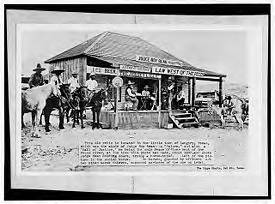
Judge Roy Bean’s Saloon in Langtry, Texas
..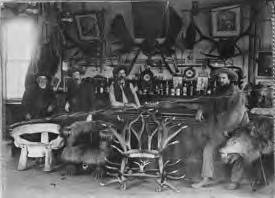
Seth Kinman's bar in 1889 in Table Bluff, California |
Click on image to enlarge

Men playing faro,
Arizona saloon, 1895 |
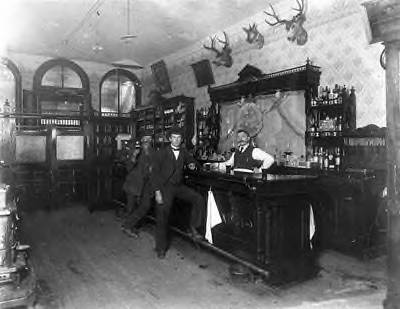
Toll Gate Saloon,
Blackhawk, Colorado, 1897 |

Bar in Columbian Hotel,
Trinidad, Colorado, 1880s |

J. W. Swart's Saloon,
Charleston, Arizona, 1885 |
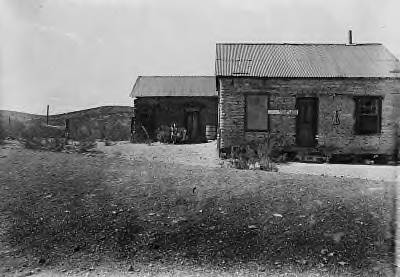
Saloon in Shakespeare,
Hidalgo County, New Mexico
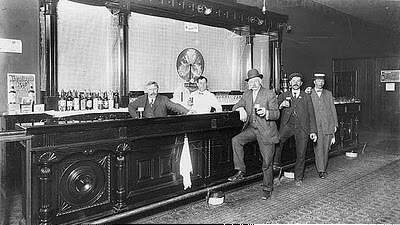
Saloon, Everett, Washington, 1907
|
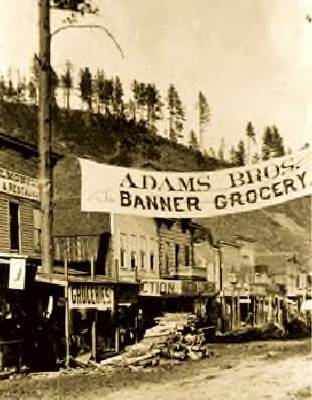
Bella Union Saloon,
Deadwood, South Dakota, 1870s |

Road House Saloon,
Bluff City, Alaska, c1906 |

Keystone Hall,
Laramie, Wyoming, 1868 |
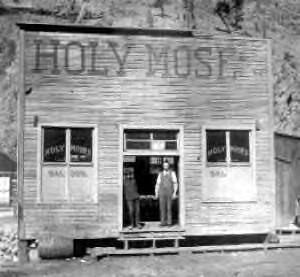
Holy Moses Saloon,
Creede, Colorado, 1890 |
Alcohol
When a town was first founded, the initial saloons were
often nothing more than tents or shacks that served homemade whiskey that
included such ingredients as “raw alcohol, burnt sugar and chewing tobacco”.
Rotgut
To stretch their profits, saloon owners would cut good
whiskey with turpentine, ammonia, gun powder or cayenne”. Their custom
product was called by names like “Tanglefoot, Forty-Rod, Tarantula Juice,
Taos Lightning, Red Eye, and Coffin Varnish.” Other offerings included
“Cactus Wine, made from a mix of tequila and peyote tea, and Mule Skinner,
made with whiskey and blackberry liquor. A saloon might also be known as
a “watering trough, bughouse, shebang, cantina, grogshop, and gin mill”.
As towns grew, saloons were often elaborately decorated,
featured Bohemian stemware, and oil paintings were hung from the wall.
The hard liquor was improved, often featuring whiskey imported from the
eastern U.S. and Europe. To avoid rotgut, patrons would request "fancy"
mixed drinks. Some of the top ten drinks in 1881 included claret sangarees
and champagne flips.
Beer
Beer was served at room temperature since refrigeration
was unavailable. Adolphus Busch introducing refrigeration and pasteurization
of beer in 1880 with his Budweiser brand. Some saloons kept the beer in
kegs stored on racks inside the saloon. A few saloons prided themselves
on homemade beer and it was not always served at room temperature.
Entertainment
By way of entertainment, saloons offered dancing girls,
some of whom occasionally or routinely doubled as prostitutes. Many saloons
offered Faro, poker, brag, three-card monte, and dice games. Other games
were added as saloons continued to prosper and face increasing competition.
These additional games included billiards, darts, and bowling. Some saloons
even included piano players, can-can girls, and theatrical skits. A current
example of this type of entertainment is the Long Branch Variety Show that
is presented in the recreated Long Branch Saloon in Dodge City, Kansas.
The Bull’s Head pizzle
Among the anecdotes of the American West, several concern
incidents that took place in or outside saloons. One such incident occurred
at The Bull’s Head Saloon in Abilene, Kansas. When the tavern’s owner,
Phil Coe, outraged the townspeople by painting a bull, complete with an
erect penis, or pizzle, on the outside wall of his tavern, Wild Bill Hickok,
the marshal at the time, threatened to burn the saloon to the ground if
the offending animal was not painted over. Instead, he hired some men to
do the job, which angered Coe. The two became enemies and in a later altercation,
Wild Bill Hickok killed Coe.
Deadwood’s No. 10 Saloon
Wild Bill, also a professional lawman, gunfighter, and
gambler, was later killed (on August 2, 1876) by Jack McCall, who shot
him in the back of the head, in Saloon No. 10, in Deadwood, South Dakota,
as Wild Bill was playing cards. His hand—aces and eights, according to
tradition—has become known as “the dead man’s hand.”
Tom Mix, bartender
According to the Reader's Digest's Story of the Great
American West, Tom Mix, who later became an actor starring in a series
of Hollywood films about the Wild West, was a bartender at the Blue Bell
Saloon in Guthrie, Oklahoma. Mix’s fellow residents included fellow actor
and comedian Will Rogers; William Wrigley Jr., the inventor of Wrigley’s
chewing gum; and prohibitionist Carry Nation.
Wyatt Earp, saloon owner
| Former lawman, Faro dealer, and gambler Wyatt Earp worked
in or owned several saloons during his life time, outright or in partnership
with others. He and two of his brothers arrived in Tombstone, Arizona Territory
on December 1, 1879 and during January 1881, Oriental Saloon owner Lou
Rickabaugh gave Wyatt Earp a one-quarter interest in the faro concession
at the Oriental Saloon in exchange for his services as a manager and enforcer.
Wyatt invited his friend, lawman and gambler Bat Masterson, to Tombstone
to help him run the faro tables in the Oriental Saloon. In 1884, after
leaving Tombstone, Wyatt and his wife Josie, Warren, James and Bessie Earp
went to Eagle, Idaho, another boom town. Wyatt was looking for gold in
the Murray-Eagle mining district. They opened a saloon called The White
Elephant in a circus tent. An advertisement in a local newspaper suggested
gentlemen 'come and see the elephant'.
In 1885, Earp and Josie moved to San Diego where the railroad
was about to arrive and a real estate boom was underway. They stayed for
about four years. Earp speculated in San Diego's booming real estate market.
Between 1887 and around 1896 he bought three saloons and gambling halls, |
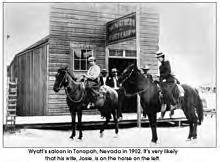
Wyatt Earp's Northern Saloon,
Tonopah, Nevada, circa 1902 |
one on Fourth Street and the other two near Sixth and E,
all in the "respectable" part of town. They offered twenty-one games including
faro, blackjack, poker, keno, and other Victorian games of chance like
pedro and monte. At the height of the boom, he made up to $1,000 a night
in profit. Wyatt particularly favored and may have run the Oyster Bar located
in the Louis Bank of Commerce on Fifth Avenue.
In the fall of 1897, Earp and Josie joined in the Alaska
Gold Rush and headed for Nome, Alaska. He operated a canteen during the
summer of 1899 and in September, Earp and partner Charles Ellsworth Hoxie
built the Dexter Saloon in Nome, Alaska, the city's first two story wooden
building and its largest and most luxurious saloon. The building was used
for a variety of purposes because it was so large: 70 by 30 feet (21 ×
9.1 m) with 12 feet (3.7 m) ceilings.
Wyatt and Josie returned to California in 1901 with an
estimated $80,000. In February, 1902, they arrived in Tonopah, Nevada,
where gold had been discovered and a boom was under way. He opened the
Northern Saloon in Tonopah, Nevada and served as a deputy U.S. Marshal
under Marshal J.F. Emmitt. His saloon, gambling and mining interests were
profitable for a period.
|
Bird Cage Theater from Wikipedia
| The Bird Cage Theatre was a combination
theater, saloon, gambling parlor and brothel that operated from 1881 to
1889 in Tombstone, Arizona during the height of the silver boom.
The Bird Cage Theatre was opened
on December 25, 1881 by William “Billy” Hutchinson and his wife Lottie.
Its name apparently referred to the 14 “cages” or boxes that were situated
on two balconies on either side of the main central hall. These boxes (also
referred to as “cribs”) had drapes that could be drawn while prostitutes
entertained their clients. The main hall contained a stage and orchestra
pit at one end where live shows were performed.
One apocryphal story alleges that
the Bird Cage Theatre took its name from the popular early 20th-century
song “A Bird in a Gilded Cage”. According to this story, the establishment
was originally named the “Elite Theatre Opera House”. One day shortly after
it opened, |
.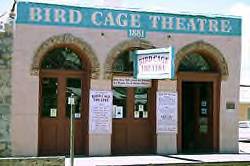
The Bird Cage Theater as it appears today. |
Eddie Foy, Sr. and songwriter Arthur
J. Lamb were standing at the bar discussing the ladies who performed there,
and Lamb allegedly said they were like “birds in gilded cages”. He then
worked out the song on a piano in the saloon, after which it was sung by
an unknown singer (Lillian Russell in some versions of the story) who was
called back by the roaring crowd eight times.
However, Lamb was born in
1870 (and therefore would have been no older than 11 or 12 years old at
the time of this story). Moreover, it appears that the establishment was
named the Bird Cage Theatre from the time it opened. Its name was briefly
changed to the “Elite Theater” after it was acquired by Joe and Minnie
Bignon in 1882 before being changed back to the Bird Cage Theatre.
The Bird Cage Theatre operated continuously
– 24 hours a day, 365 days a year – for the next 8 years. It gained a reputation
as one of the wildest places in the country, prompting The New York Times
to report in 1882 that "the Bird Cage Theatre is the wildest, wickedest
night spot between Basin Street and the Barbary Coast". More than 120 bullet
holes are evident throughout the building.
Aside from Lillian Russell, many
other famous entertainers of the day were alleged to have performed there
over the years, including Eddie Foy, Sr., Lotta Crabtree and Lillie Langtry.
In 1882, Fatima allegedly performed her belly-dancing routine at the Bird
Cage Theatre.
The basement poker room is said
to be the site of the longest-running poker game in history. Played continuously
24 hours a day for eight years, five months, and three days, legend has
it that as much as 10 million dollars changed hands during the marathon
game, with the house retaining 10 percent. Some of the participants were
Doc Holliday, Bat Masterson, Diamond Jim Brady, and George Hearst. When
ground water began seeping into the mines in the late 1880s the town went
bust, the Bird Cage Theatre along with it. The poker game ended and the
building was sealed up in 1889.
The building was not opened again
until it was purchased in 1934, and the new owners were delighted to find
that almost nothing had been disturbed in all those years. It has been
a tourist attraction ever since, and is open to the general public year-round,
from 8:00 am to 6:00 pm daily.
|
| Long Brach saloon from Wikipedia
The Long Branch Saloon is a famous saloon that existed
during the Old West days of Dodge City, Kansas. It had numerous owners,
most notably Chalk Beeson and gunfighter Luke Short. The establishment
was the scene of many altercations, shoot-outs, gunfights and standoffs
often associated with the then-wild cattle town, the most famous of which
was the Long Branch Saloon Gunfight, in which Frank Loving killed Levi
Richardson.
The original saloon was built during the late-1870s and
was named the Long Branch by its first owner, William Harris, after his
hometown of Long Branch, New Jersey. It was a plain, storefront bar with
little ornamentation, which was typical for frontier saloons of the time.
Throughout its most active times, numerous Old West characters passed through
or did business inside the Long Branch, such as Clay Allison, Wyatt Earp,
Doc Holliday, Frank Loving, Dave Mather, Bat Masterson and his brothers
Ed and James, Charlie Bassett, and a host of others. Professional gambler
and gunfighter Luke Short's purchase of a partial interest in the Long
Branch in 1883 is credited as one of the causes of the bloodless Dodge
City War.
Its fame and legend increased when it was featured in
almost every episode of the longest-running television drama, Gunsmoke.
The original saloon is long gone, but a romanticized recreation of the
Long Branch saloon, based mostly upon the television show Gunsmoke, exists
today as part of the Dodge City Boot Hill Museum. The current Long Branch
Saloon is home to the Long Branch Variety Show, a western saloon show,
that has been presented nightly throughout the summer months since 1958
making it the longest-running seasonal show in the country. Created by
Rosemary & Lewis Mock, the show is hosted by Miss Kitty and includes
musical numbers, comedy, and, of course, the Can-Can.
|
| It is July and I was going to do a Declaration of Independence
article but due to it's size I have placed a link here for those interested.
United
States Declaration of Independence from Wikipedia
|
.
All articles submitted to the "Brimstone
Gazette" are the property of the author, used with their expressed permission.
The Brimstone Pistoleros are not
responsible for any accidents which may occur from use of loading
data, firearms information, or recommendations published on the Brimstone
Pistoleros web site. |
|